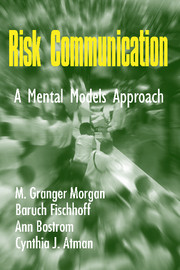Book contents
- Frontmatter
- Contents
- Preface
- Risk Communication
- 1 INTRODUCTION
- 2 OUR MENTAL MODELS APPROACH
- 3 CREATING AN EXPERT MODEL OF THE RISK
- 4 MENTAL MODELS INTERVIEWS
- 5 CONFIRMATORY QUESTIONNAIRES
- 6 DEVELOPMENT AND EVALUATION OF COMMUNICATIONS
- 7 CASE STUDIES: APPLICATIONS TO ENVIRONMENTAL RISKS
- 8 A MENTAL MODELS APPROACH TO HIV/AIDS
- 9 SOME CONCLUDING THOUGHTS
- Appendix A Brochure on global warming and climate change
- Appendix B Brochure on fields from electric power
- Appendix C Risk communication materials on HIV/AIDS
- Appendix D Sample transcripts of mental model interviews
- Index
9 - SOME CONCLUDING THOUGHTS
Published online by Cambridge University Press: 05 June 2012
- Frontmatter
- Contents
- Preface
- Risk Communication
- 1 INTRODUCTION
- 2 OUR MENTAL MODELS APPROACH
- 3 CREATING AN EXPERT MODEL OF THE RISK
- 4 MENTAL MODELS INTERVIEWS
- 5 CONFIRMATORY QUESTIONNAIRES
- 6 DEVELOPMENT AND EVALUATION OF COMMUNICATIONS
- 7 CASE STUDIES: APPLICATIONS TO ENVIRONMENTAL RISKS
- 8 A MENTAL MODELS APPROACH TO HIV/AIDS
- 9 SOME CONCLUDING THOUGHTS
- Appendix A Brochure on global warming and climate change
- Appendix B Brochure on fields from electric power
- Appendix C Risk communication materials on HIV/AIDS
- Appendix D Sample transcripts of mental model interviews
- Index
Summary
The preceding chapters have described the method and motivation for the Carnegie Mellon mental models approach to developing risk communications and attempted to provide enough worked examples to allow readers to implement each of its components on their own. We hope that readers will take our words as intended: as guidance on how to get started, not gospel to be followed slavishly in every detail. In addition to an empirical understanding of the science and perception of risk, good risk communications require imagination and creativity. Each application has presented us with new challenges and generated new methods. That, presumably, will be your experience as well. This guide is intended as a cookbook in the sense of a guide to planning nutritious meals rather than a set of recipes for specific dishes (although we have provided a few of our favorites).
The Cost of Risk Communication
The procedure that we have outlined takes time and effort. As noted in Chapter 2, while a rough version of the process might be accomplished with two or three person-months of effort, a thorough job may require between three to four times that. An organization preparing multiple communications might achieve economies of scale by reusing portions of protocols, interviewer training, results, and messages. Indeed, some of the specific pieces in our worked examples might be directly adapted to some settings (e.g., how to communicate cumulative risk (Chapter 8), air flows and radioactive decay (Chapter 6), fields (Chapter 7), the effect of drinking on judgment (Chapter 8), and the effect of values on policy choices (Chapter 7)).
- Type
- Chapter
- Information
- Risk CommunicationA Mental Models Approach, pp. 179 - 184Publisher: Cambridge University PressPrint publication year: 2001



